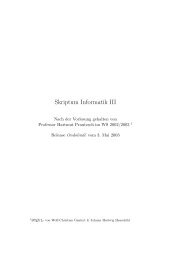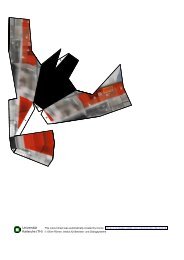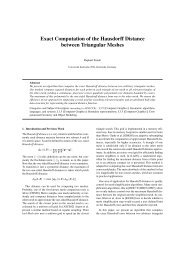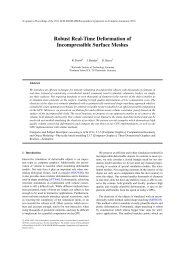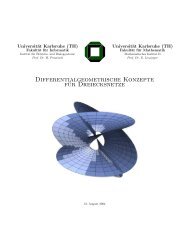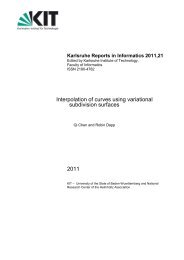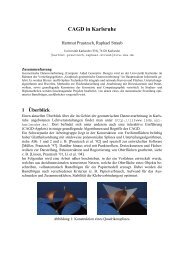On the Convergence and Correctness of Impulse-Based Dynamic ...
On the Convergence and Correctness of Impulse-Based Dynamic ...
On the Convergence and Correctness of Impulse-Based Dynamic ...
Create successful ePaper yourself
Turn your PDF publications into a flip-book with our unique Google optimized e-Paper software.
- 6 -<br />
To start this short exposition on impulse-based dynamic simulation, we define <strong>the</strong> function LA =<br />
look-ahead by<br />
2<br />
(2.5) LA( Pr( t), h): = Pr( t) + P& r( t) ⋅ h+ 0.5⋅gr<br />
⋅h<br />
.<br />
It defines <strong>the</strong> location where <strong>the</strong> associated point mass will be found at time t+ h with a purely<br />
ballistic motion. (This equation is also applicable to point masses fixed in space, for<br />
P& r () t = (0,0,0) <strong>and</strong> g r = (0,0,0) always apply to <strong>the</strong>m.)<br />
With <strong>the</strong> iterative impulse-based method <strong>of</strong> dynamic simulation, a time step from t to t+ h is<br />
carried out as follows:<br />
(2.6) Iterative integration step:<br />
As long as a constraint C = ( i , j , d ) can be found satisfying<br />
k k k k<br />
LA( P ( t), h) −LA( P ( t), h) − d > δ , proceed as follows:<br />
jk ik k<br />
max<br />
(1) The correction impulse has <strong>the</strong> magnitude <strong>and</strong> direction<br />
LA( Pj ( t), h) −LA( P ( ), )<br />
k i t h −d<br />
k<br />
k A ()<br />
:<br />
k t<br />
I = ⋅ .<br />
h⋅ ((1/ m ) + (1/ m )) A ( t)<br />
jk ik k<br />
(2) Complementary application <strong>of</strong> <strong>the</strong> impulse I changes <strong>the</strong> velocities <strong>of</strong> <strong>the</strong> point masses involved<br />
at time t as follows:<br />
P& i (): t = P& () (1/ ) ,<br />
k i t + m<br />
k i ⋅I<br />
k<br />
P& (): t = P& () t −(1/ m ) ⋅I.<br />
jk jk jk<br />
(3) If such a constraint can no longer be found, update <strong>the</strong> dynamic state <strong>and</strong> advance <strong>the</strong> time to<br />
t+ h by<br />
Pi ( t+ h): = LA( P ( ), ),<br />
k i t h<br />
k<br />
Pj ( t+ h): = LA( P ( ), ),<br />
k j t h<br />
k<br />
P& ( t+ h): = P& ( t) + g ⋅ h, P& ( t+ h): = P& ( t) + g ⋅h<br />
ik ik ik jk jk jk<br />
<strong>and</strong> continue <strong>the</strong> simulation with this new dynamic state.<br />
This is <strong>the</strong> simplest dynamic simulation algorithm known as far as <strong>the</strong> programming requirements<br />
are concerned. We apply correction impulses at <strong>the</strong> individual point masses, namely at time t , until<br />
all constraints are satisfied at <strong>the</strong> look-ahead time t+ h,<br />
within tolerances smaller than δ max .<br />
12<br />
Depending on <strong>the</strong> requirements, very small values such as max : 10 δ<br />
−<br />
= can be chosen.<br />
Complementary application <strong>of</strong> <strong>the</strong> impulses conserves <strong>the</strong> linear momentum as well as <strong>the</strong> angular<br />
momentum <strong>of</strong> <strong>the</strong> PMS, but a requirement for this is that <strong>the</strong> system has no point masses fixed in<br />
space. (Note that gravity does change <strong>the</strong> linear momentum.)<br />
We carry out <strong>the</strong> iterative velocity correction in a very similar manner, with <strong>the</strong> objective <strong>of</strong><br />
converting a non-V-consistent PMS into a V-consistent one, merely through <strong>the</strong> application <strong>of</strong><br />
complementary pairs <strong>of</strong> impulses. The point locations P i are not modified in <strong>the</strong> process, only <strong>the</strong><br />
Pi & .



